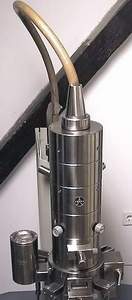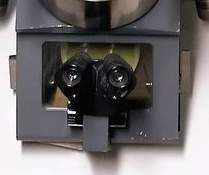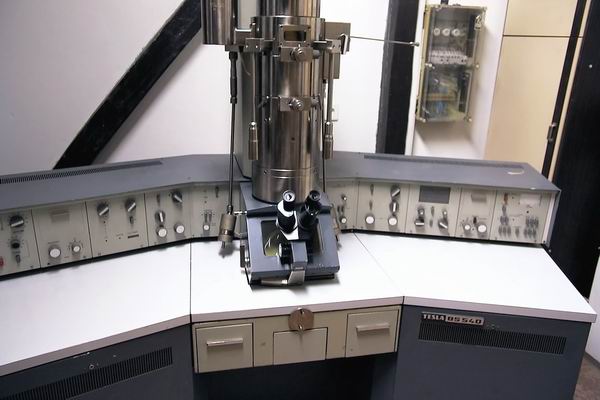 32.
WORDTIME 32.
WORDTIME  FROM ATOMS TO THE CELLS |
|
|
|
|
|
This instrument does have a weird and not well-known advantage. It creates a three dimensional image in a film. The film, as a recording instrument is very cumbersome because even those things have to be put into the high vacuum which is not liked be all film materials and besides it is an entirely separate procedure to make vacuum in the great compartment which can be seen in the middle of it. The two little doors on the sides are the preparators and you have to put the prepared films in the middle one. These are flat films and they are tucked in a weird little feeder and so only a small number of shots can be taken with them and when the film has run out in the feeder the light stopper lid has to be slid on it and only than can you open that little door over which you can see the small knob and then you have to do the whole elaborate film developing of those flat films. |
|
|
All this is very backwards and cumbersome, but still you get something which your electronic imager will never show. The wave nature of the electrons causes such a wave interference in our film which has so far been thought to be an incontinent side effect as it makes the image quite blurry and ruins it with little rings. A similar phenomenon can also occur in the case of light. The photographers really hate it, especially because it causes blurry lines patterns around the contrasting edges. Here, electrons draw the image, which are much larger than light quanta, therefore, the moire is much more visible in the images. The entire electron microscope in its basic principles is very similar to the operation of the picture tube of TVs. Only, this one has a little larger cathode voltage, which has a quite sturdily designed power cord, which I am showing in the picture below. |
|
 |
Here's the glow-cathode at the top, which is designed as interchangeable, since with a wrongly evacuated microscope an instant is enough for it to burn away. There is a similar one in TV cables, and there is only this one electron tube in today?s TVs . It is not long before they go out of use since plasma and LCD screens have already appeared. The thermionic cathode is positioned on top of the tapered part and this produces the electrons for imaging. Electron lenses are placed under it which - similarly to lens optics - will make the disobedient electrons suitable for enlargement and imaging. They are also a type of deflection coils. The two gray buttons are for their adjustment and settings. The inspection windows (the smaller one in the middle and the larger down below were made of finger-thick led glass) Nevertheless, the whole structure has a fairly easily measurable X-ray radiation. Apart from these inconveniences, we also see benefits. That little unpleasant moire allows for a true 3D holographic imaging method. This is of great importance, although the scanner electron microscope foreshadowed this ten years ago. Magnification by half a million times already makes the image blurred, however, with this the secret and hiding properties improve more, as this will improve the 3D character of an image. The main culprit is vacuum. This will destroy life. The object prepared in a tremendously complicated way can be moved or magically conjured into place with the object-funnelet which can be moved even in vacuum with little protruding gadget on the right. Good sport... |
 |
Well, I?ll show you the little specs that lets you see the image with the naked eye. This can be moved right or left and its set on that round plate which can be seen a bit over the specs. It is covered with a green fluorescent material, which lights up because of the incoming electrons. The magnified image glowing in green is displayed on it. Underneath is the film dispenser cartridge and this slanted round plate can be turned up with that small arm seen on the side of the instrument with just one flick of a finger. This instrument is a museal curiosity, however, it can still be of useful service in research. High vacuum is created by a rotational and diffusion pump and together, but certainly over many hours. While this is being done, you had better connect it to the Inota Power Plant that is how much power it uses from three phases. The own-weight of the gadget may be around a ton. |
|
For this reason they have come up with some more
modern equipments, but we can not afford those these days. Light
microscopes cannot really be pushed over an 1200x resolution. (But
there are tricks, which would doubled their performance. Hungarian
invention.) . We have concocted a TEM (Tunnel Effect Microscope)
microscope which already shows the atoms but this is not enough for
the understanding of life. As the Nobel Prize-winning professor
Szentgy”rgyi said: "If we want to understand life, we should at least
go down to the level of the electrons." |
|
|
I know that today?s science is incredibly far away from this conception, those modern observations will fill in the gap more and more in the times ahead which are made possible by our increasingly more sophisticated devices. What was claimed to be completely impossible a hundred years ago is now viewed as obsolete today. A punch card could record up to 80 characters. (80 bytes). My disk can hold one billion times more. How many cubic meters would that be in punch cards? This takes up just one cigar holder of a place in my machine. How many trees were cut off for the punch cards? This one time, I fixed a five Mega Bulgarian disc, which was like sixty kilos, and was as big as an old bedside table. Young people today believe that it is called a bedside table because it is in the bedroom. (And the potty was confined in it along with the product. The entire family was going there all night. This was the toilet.) |
|
|
Well, these noxiously (very stinky) organized materials are also a part of life. Szar in Sumerian only means final result, sum. And that is what it is. And yet, to add a little bit of a twists, The Creator, nus in Latin; means wit, intellect. (See: manus) I broached this because of the Latin name of the butt-hole, the anus . All of these, way back, were never understood as disgusting, unpronounceable, shameful terms that would make one blush like these days. Today, almost all the human stuff is said in Latin. I do not think it does anything to the meaning. Latin is not a least bit nicer, or if you say poopoo. I don?t care what the snobs and puritanical keep telling me (Nicht vor dem Kind!; Not in front of the kids!) , they say it in a different language but not a bit nicer. For me, its my mother tongue that does it. For an average man, when they hear the word Matahari an Eastern-born a danceuse working in Paris, executed for espionage comes to mind, yet, this is how they call in the Indonesian language the Sun. . Japanese say DEI which is there in the Romance languages as well, but there it just means God. Is it not thought-provoking?
|
|
|
ALL RIGHTS RESERVED © 2007 UNIVERSUM UNIVERSITAS.
This publication was prepared for personal use only.
|
|
 Previously
we started discussing life but we clearly saw logically that in order
to go straight to the meat of the matter we need to go way beyond the
level visible to the naked eye. Microscopes in use today are
insufficient for understanding what life really is because it is
exactly the essence, the gist of life, what they fail to show. The
magnification of an electron microscope is still just a distant peek.
The resolving power of this instrument is 540000 times but it will not
show the atoms yet. It would be very good, though, if it could. I am
quite familiar with this equipment because I have one of my own. It's
here is my lab. (Rather, the sacristy ...)
Previously
we started discussing life but we clearly saw logically that in order
to go straight to the meat of the matter we need to go way beyond the
level visible to the naked eye. Microscopes in use today are
insufficient for understanding what life really is because it is
exactly the essence, the gist of life, what they fail to show. The
magnification of an electron microscope is still just a distant peek.
The resolving power of this instrument is 540000 times but it will not
show the atoms yet. It would be very good, though, if it could. I am
quite familiar with this equipment because I have one of my own. It's
here is my lab. (Rather, the sacristy ...)
